Uncover India’s literary treasures with our curated list of the best books written by Indian authors. Explore diverse narratives and enrich your reading list!
India, a land as diverse as it is vast, boasts a literary heritage that stretches back millennia, approximately 3300 BCE, to be exact. Many languages, cultures, and traditions lie within its borders — all reflected in the country’s literature. Indian authors provide a unique perspective in the literary world, allowing readers around the world to learn about their culture and experiences. If you’re looking for gift ideas, read our guide with the best books to give to loved ones.
Contents
- 1. Midnight’s Children by Salman Rushdie
- 2. The God of Small Things by Arundhati Roy
- 3. A Suitable Boy by Vikram Seth
- 4. The White Tiger by Aravind Adiga
- 5. Train to Pakistan by Khushwant Singh
- 6. The Palace of Illusions by Chitra Banerjee Divakaruni
- 7. Swami and Friends by R.K. Narayan
- 8. The Namesake by Jhumpa Lahiri
- 9. The Shadow Lines by Amitav Ghosh
- 10. Clear Light of Day by Anita Desai
- 11. The Guide by R.K. Narayan
- 12. Interpreter of Maladies by Jhumpa Lahiri
- 13. The Great Indian Novel by Shashi Tharoor
- 14. Em and the Big Hoom by Jerry Pinto
- 15. The Immortals by Amit Chaudhuri
- 16. Fasting, Feasting by Anita Desai
- 17. The Inheritance of Loss by Kiran Desai
- 18. The Hungry Tide by Amitav Ghosh
- 19. Sacred Games by Vikram Chandra
- 20. Poonachi: Or the Story of a Black Goat by Perumal Murugan
- 21. English, August by Upamanyu Chatterjee
- 22. The Far Field by Madhuri Vijay
- 23. Serious Men by Manu Joseph
- 24. The Death of Vishnu by Manil Suri
- 25. A Fine Balance by Rohinton Mistry
- FAQs About Best Books Written by Indian Authors
1. Midnight’s Children by Salman Rushdie
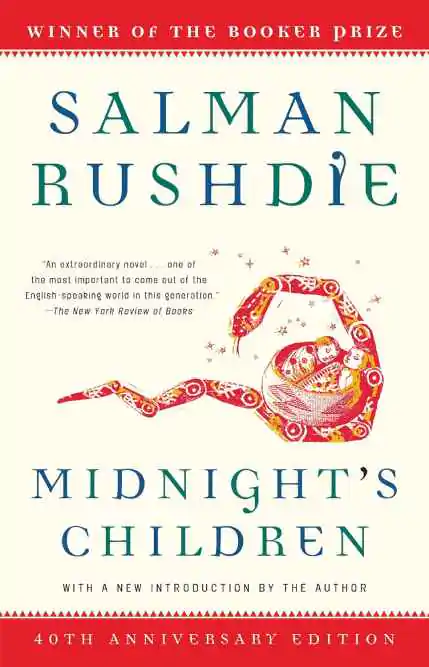
Midnight’s Children takes readers back to the midnight of August 15, 1947, when India took its independence from the British Empire. The novel then follows a pair of children switched at birth in Bombay.
Saleem Sinai, the narrator, has been constantly pressured by expectations since birth. One day, as his mother punishes him, he discovers he has the power of telepathy. Throughout the novel, readers realize that the 1,000 babies (now only 581) born at the first hour of India’s independence have magical abilities.
Through this main plot, Salman Rushdie delves into themes of identity influenced by Indian mentality, politics, and human relations. Sprinkled over the 600-page work are elements of magical realism excellently meshed with the Indian-British’s wit and humor. Read it on Amazon; click here.
“From the beginning men used God to justify the unjustifiable.”
Salman Rushdie, Midnight’s Children
2. The God of Small Things by Arundhati Roy

The God of Small Things is a modern classic that is fascinating and heart-breaking. The story’s central plot revolves around the fraternal twins, Estha and Rahel, and their experiences since childhood and as adults. The book contains usually frowned-upon themes, but they play important parts in making the novel whole.
Many label Roy’s work as haunting but also clever. She skillfully interweaves family drama, forbidden affections, and political commentary. Roy has a way of creating characters with depth through her insight. She writes with intent and carefully creates the book’s atmosphere. In doing so, she doesn’t need to explain to the readers why a character behaves the way they do. Readers just understand.
Another unique aspect of Roy as a writer is her fondness for breaking rules in the English language. She capitalizes words, combines one or two words, and deliberately misspells. She does these to demonstrate a foreigner’s mind and way of thinking. Read it on Amazon; click here.
“It is curious how sometimes the memory of death lives on for so much longer than the memory of the life that it purloined.”
Arundhati Roy, The God of Small Things
3. A Suitable Boy by Vikram Seth
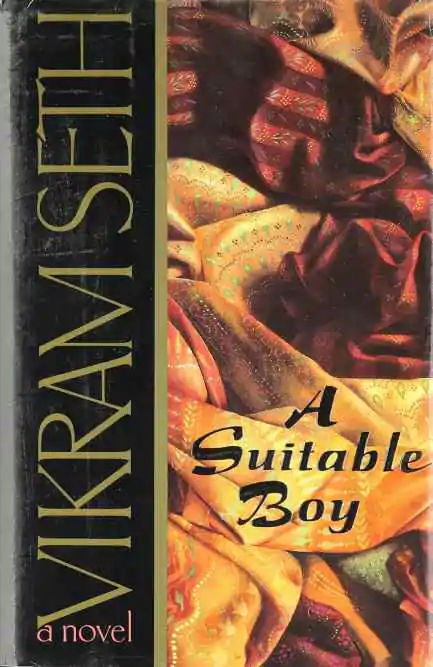
With almost 1,500 pages to go through, A Suitable Boy successfully paints a comprehensive view of family life and Indian heritage. The title refers to Lata’s search for a great match, highlighting arranged marriages as a central concern in Indian culture. Aside from these main themes, Seth presents vital but little-known events, like the Partition of India.
Seth’s narrative involves four families — those from the rich and powerful and those from the poor and lacking. He also describes court proceedings and politics in detail. All are to give the readers a complete survey of the characters’ motivations. Seth’s book is an excellent microcosm of life during the 50s. Read it on Amazon; click here.
“Think of many things. Never place your happiness in one person’s power. Be just to yourself.”
Vikram Seth, A Suitable Boy
4. The White Tiger by Aravind Adiga

The White Tiger follows the success story of Balram Halwai. He was once a poor villager, an ill-treated driver, and a wealthy entrepreneur. Readers can uncover his personal history via his letter to the Chinese leader Wen Jiabao, who was keen on learning Indian entrepreneurship.
Through his service to a rich family, Balram becomes educated. Driving the landlord, the landlord’s son who came from New York, and others made it easy to listen and learn. His studying took him to New Delhi, and the events that followed made him realize the realities of the system.
Through this debut novel, Adiga showcases the dire circumstances of various social statuses in India. He demonstrates the poor conditions of those in the streets. But he also tackles the crimes and willingness of those in power to sacrifice their kin. Read it on Amazon; click here.
“Iqbal, that great poet, was so right. The moment you recognize what is beautiful in this world, you stop being a slave.”
Aravind Adiga, The White Tiger
5. Train to Pakistan by Khushwant Singh
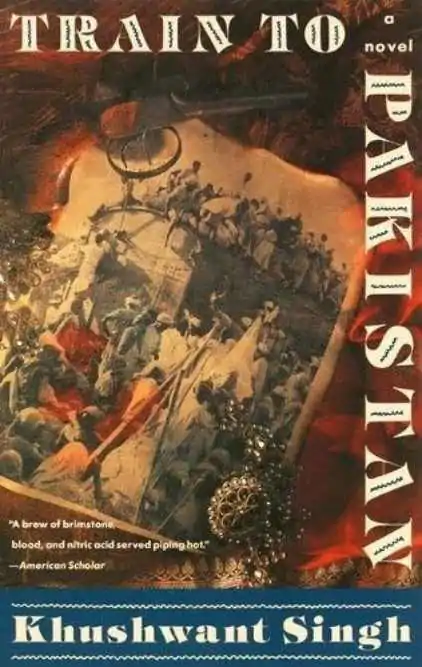
Train to Pakistan takes the results of the 1947 Partition of India from mere statistics to harrowing realism. It depicts the British leaving a broken country behind, with religion further dividing the people. Singh shows the gap between Hindus and Muslims by centering the plot around the small village of Mano Majra.
The central theme revolves around the two groups living in harmony within the village. Through it, Singh presents that unity despite varying religious beliefs is possible. However, he also demonstrates how religion persuades people to do things — good and bad. Aside from the macrocosm of the events unfolding in the novel, it also tells of a love story between a Sikh man and a Muslim woman.
Singh skillfully captures the brutality of the Partition of India in Train to Pakistan. All within a veil of soothing writing. This choice of style makes the book easier to read and digest. Read it on Amazon; click here.
“Freedom is for the educated people who fought for it. We were slaves of the English, now we will be slaves of the educated Indians — or the Pakistanis.”
Khushwant Singh, Train to Pakistan
6. The Palace of Illusions by Chitra Banerjee Divakaruni
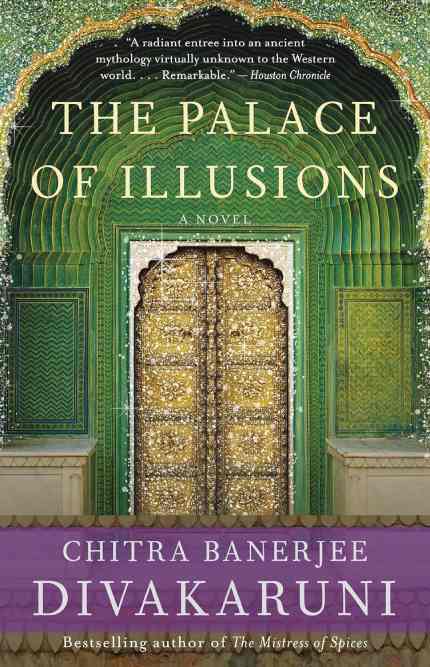
Go on a journey with the heroine of the Mahabharata in The Palace of Illusions. It’s a novel of myth, magic, and history interconnected to retell an epic tale. Above all, it unveils women’s struggles seen through the perspective of one of the most famous women in Indian ancient texts.
Readers can rediscover the characters’ strengths and weaknesses in this epic version. Draupadi (also called Panchaali, Krishna, and Yagyaseni) is not just a helpless female in this novel. She’s a strong woman who endures hardships and helps her husbands get their kingdoms.
Divakaruni introduces new angles and vital points in the story. For instance, Draupadi’s disrobing that made the war inevitable is justified and given more weight. At the same time, the story also chastises the main lead’s choices and shows the effects of her mistakes. Read it on Amazon; click here.
“Expectations are like hidden rocks in your path — all they do is trip you up.”
Chitra Banerjee Divakaruni, The Palace of Illusions
7. Swami and Friends by R.K. Narayan

Any 20th-century child will see themselves in the characters of Swami and Friends. This novel may seem simple and comedic. But in reality, it showcases R.K. Narayan’s genius in entering a child’s mind and reliving his experiences with the readers. It’s a fascinating throwback to one’s early years, where innocence is at its peak.
Swami and Friends, only one part of the A Malgudi Omnibus collection, is undeniably one of the children’s adventure classics in Indian literature. Readers can relate to the ten-year-old boy, Swami, as his relationship with others deepens. It talks of his friends, grandmother, parents, and new-born brother. This book is an intimate and thorough tale of childhood, family, and growth. Read it on Amazon; click here.
“Life is about making the right things and going on.”
R.K. Narayan, Swami and Friends
8. The Namesake by Jhumpa Lahiri
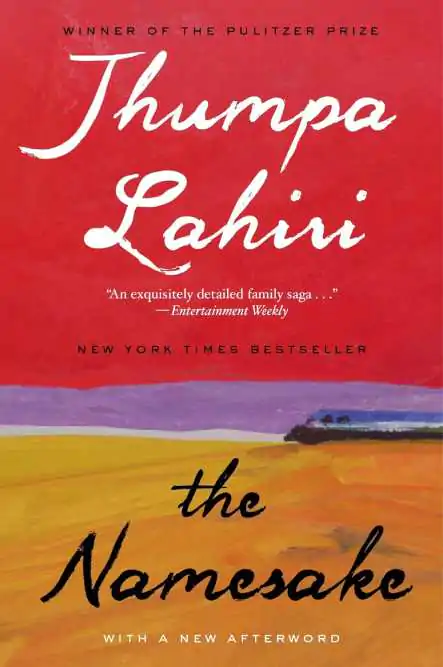
Since an Indian immigrant family’s story is told in The Namesake, many in the same boat will relate to the novel. Jhumpa Lahiri’s emotionally charged writing makes the novel a must-read. It’s about parents integrating their Indian heritage from Calcutta into their life in New York.
Simultaneously, it’s also their children’s struggles with their identities. Lahiri’s writing shines through the firstborn son’s perspective, who hates the name given to him. Readers join in as Gogol rebels against his family’s values and lifestyle, even wanting to change his name. He does so because he needs to learn the meaning and symbolism of the name his father picked. Read it on Amazon; click here.
“She has the gift of accepting her life; as he comes to know her, he realizes that she has never wished she were anyone other than herself, raised in any other place, in any other way.”
Jhumpa Lahiri, The Namesake
9. The Shadow Lines by Amitav Ghosh
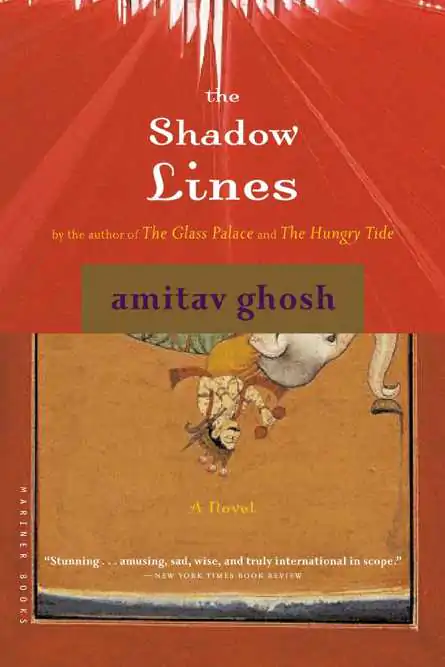
Travel with a boy who traverses between the intricate web of dreams and memories in The Shadow Lines. It’s a fiction book that excellently blends magic, Indian history, and youthful innocence. Like other works depicted in Indian books, Ghosh also mentions Partition literature, the Swadeshi movement, and World War II but deftly narrates them in a more interesting way. It also discusses the Dhaka and Calcutta Riots.
The Shadow Lines presents an almost omniscient, unnamed narrator and assists readers in being more critical of what philosophical themes mean. This includes unity, boundaries, and alienation. Read it on Amazon; click here.
“Need is not transitive; one may need without oneself being needed.”
Amitav Ghosh, The Shadow Lines
10. Clear Light of Day by Anita Desai
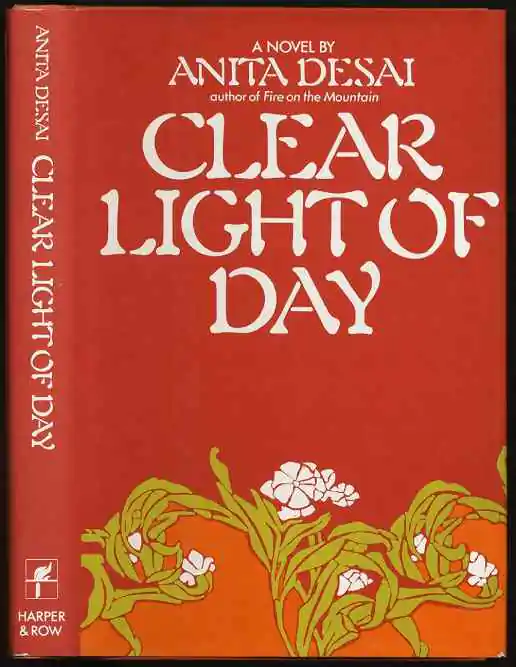
Clear Light of Day focuses on a family and the post-partition’s influence on each member. The story starts with the sisters and brothers as adults and continues as they recount their lives. This recounting opens up an avenue for them to analyze their domestic lives and relationships. It’s also a way to reflect on how India transformed over the years.
Desai focuses on one family’s struggles and how their lives play out alongside one of the most tumultuous parts of Indian history. In doing so, Desai successfully portrays the characters’ maturity and their country moving on from its past. Read it on Amazon; click here.
“That was the way life was: it lay so quiet, so still that you put your fingers out to touch it, to stroke it. Then it leapt up and struck you full in the face so that you spun about and spun about, gasping. The flames leapt up all around, rising by inches every minute, rising in rings.”
Anita Desai, Clear Light of Day
11. The Guide by R.K. Narayan

The Guide tells the story of Raju. He’s a simple expediter, turned to Malgudi’s spiritual guide and, finally, one of India’s holy men. The book is about a man’s journey to being a guru. All told in a non-linear narrative that makes the themes easier to digest.
Passion, tradition, and piety are only some of the issues Narayan tackles via The Guide. Raju, as a character, is carefully crafted, with likable but also despicable characters, making him a realistic, relatable character. Read it on Amazon; click here.
“We always question the bonafide of the man who tells us unpleasant facts.”
R.K. Narayan, The Guide
12. Interpreter of Maladies by Jhumpa Lahiri

Nine short stories compose the Interpreter of Maladies. These stories are of Indian and Indian Americans who integrate their past and current lives. Gradually, these tales uncover the reality behind every character’s expectations versus what life offers them in a foreign land.
This award-winning work untangles the difficulties of clashing cultures and life adjustments. It’s one of the best Indian culture presentations on paper, with authentic interpersonal themes shared through moving narratives. Read it on Amazon; click here.
“That’s the thing about books. They let you travel without moving your feet.”
Jhumpa Lahiri, Interpreter of Maladies
13. The Great Indian Novel by Shashi Tharoor
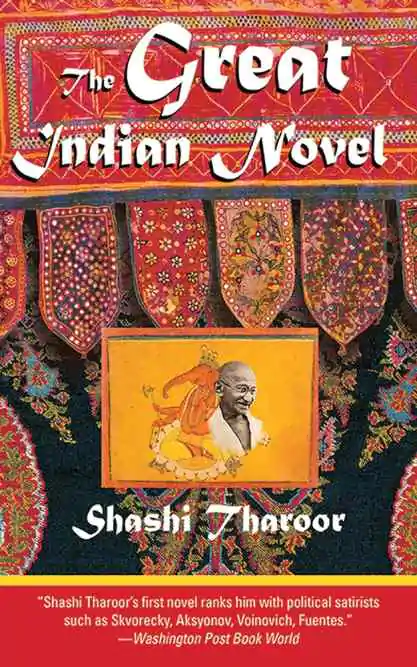
In The Great Indian Novel, Shashi Tharoor retells The Mahabharata through a modern political stance. He creates a thought-provoking and funny book by using the ancient poem’s characters and putting them in modern India. Additionally, the author digs into the epic’s influences and other impacts of colonial rules over India’s freedom.
Expect to read about Nehru, Gandhi, and many more through the eighteen books in the novel. Tharoor weaves an intricate plot. But even if you’re unfamiliar with Indian history or epics, the plot will still be easy to follow. Read it on Amazon; click here.
“The past is not necessarily a guide to the future, but it does partly help explain the present.”
Shashi Tharoor, The Great Indian Novel
14. Em and the Big Hoom by Jerry Pinto
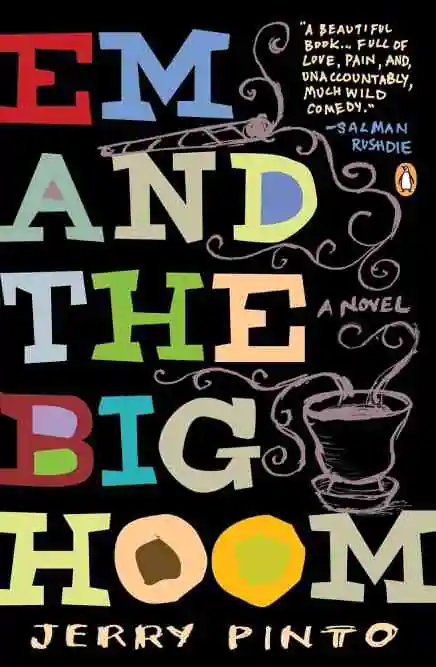
Em and the Big Hoom refers to the narrator’s parents — Imelda and Augustine. Readers are offered the young storyteller’s perspective. Through the kid’s eyes, readers are introduced to his family life, which is both comedic and filled with sorrow.
It’s a story of a mother and the family that loves her. She’s the perfect woman, aside from her bipolar disorder. The book is touching on how mental illness affects a family and children. Jerry Pinto chose to tackle mental health issues in his debut novel. Though discussing mental illnesses is never an easy task, he presents it sincerely and bitingly humorously. Read it on Amazon; click here.
“I am no I. I am now part of a we.”
Jerry Pinto, Em and the Big Hoom
15. The Immortals by Amit Chaudhuri
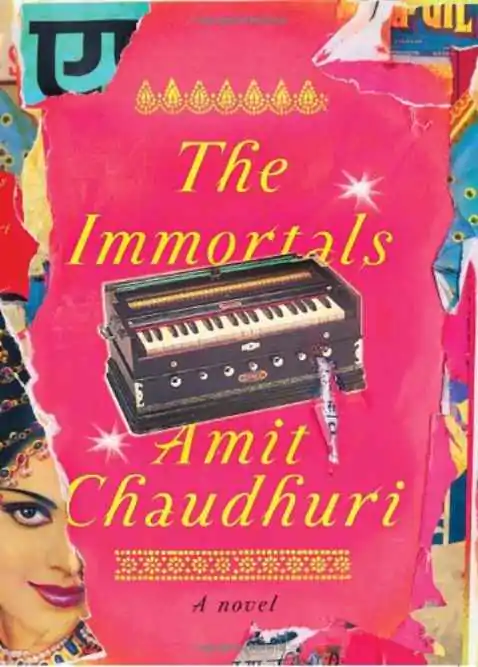
The Immortals is the story of the relationship between an affluent voice teacher and a student. In a deeper sense, it’s about the peculiarities between India’s upper and lower classes. Moreover, it’s a tale criticizing perceptions and ideals.
Chaudhuri’s writing paints a vivid description of India forty years ago. He describes sights, sounds, and even scents so that readers feel they are within the book’s pages. Readers who are not familiar with native words will do well to have a glossary for a more immersive reading. Read it on Amazon; click here.
“She knew, with an uncomplicated honesty, what her worth was; to what extent would she compromise or to which level stoop if others pretended not to.”
Amit Chaudhuri, The Immortals
16. Fasting, Feasting by Anita Desai

Anita Desai takes Indian family dynamics to the forefront in Fasting, Feasting. An “unmarriageable” daughter, a pressured son, and rigid parents — the book reflects many Indian households then and today.
Aside from the conflict between the new and old generations, the author inspects how immigrant children assimilate to a new land. Desai combines elements of bleak humor and tragedy in her narrative. This skillful writing style makes readers feel like they are part of the suburban family tied to their beliefs. Read it on Amazon; click here.
“Wherever you go becomes a part of you somehow.”
Anita Desai, Fasting, Feasting
17. The Inheritance of Loss by Kiran Desai

The Inheritance of Loss intermingles the lives of people who participate and want to get out of India’s caste system. It has four main characters. First, Jemu, a retired judge who studied in London and now lives in the Himalayas. Then, his orphaned granddaughter Sai.
Readers become aware of the character’s struggles through a third-person omniscient point-of-view. These difficulties are products of globalization and loss of identity. Read it on Amazon; click here.
“Sadness was so claustrophobic.”
Kiran Desai, The Inheritance of Loss
18. The Hungry Tide by Amitav Ghosh
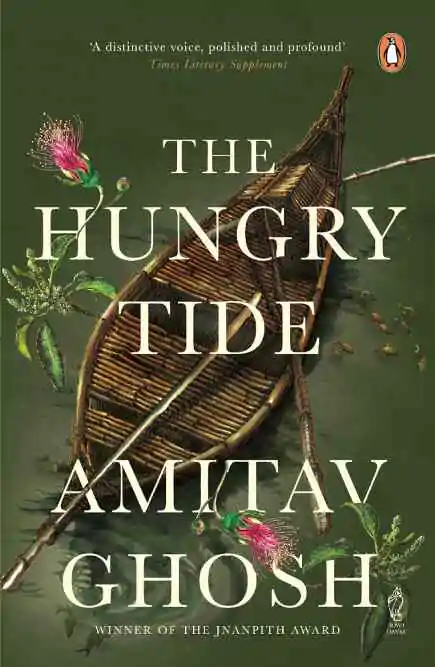
The Hungry Tide is an unlikely tale of nature and humanity. Readers are introduced to two main characters, one an Indian American researcher leaning more to her American descent, and another an Indian fisherman who saved her. Other characters are used, but the central theme remains true: man and nature can coexist, but at what cost?
Ghosh is known for his in-depth sense of socio-political matters. Through lyrical writing, he lures readers in and poses questions about altruism, economy, and religion. Readers can expect well-paced scenes that culminate into an impactful climax. Read it on Amazon; click here.
“Need is not transitive; one may need without oneself being needed.”
Amitav Ghosh, The Hungry Tide
19. Sacred Games by Vikram Chandra
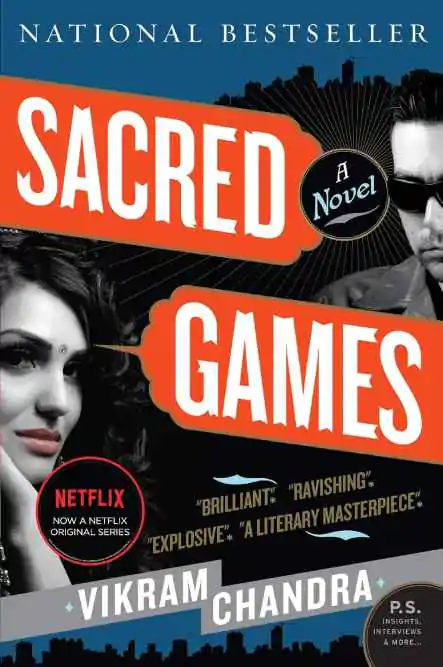
Tagged as a thriller mystery novel, the Sacred Games takes readers on an adventure of Mumbai’s underworld criminals and a Sikh police officer’s hunt. Here, the author successfully depicts the chaos and violence of 21st-century India.
Using his many inspirations, including 19th-century classics and Bollywood cinema, Chandra illustrates India’s dark world with ease and urgency. This 900-page novel creates a complete saga that uses real-world Indian texts and explains Indian culture. Read it on Amazon; click here.
“The truth is that human beings like to be ruled. They will talk and talk about freedom, but they are afraid of it.”
Vikram Chandra, Sacred Games
20. Poonachi: Or the Story of a Black Goat by Perumal Murugan
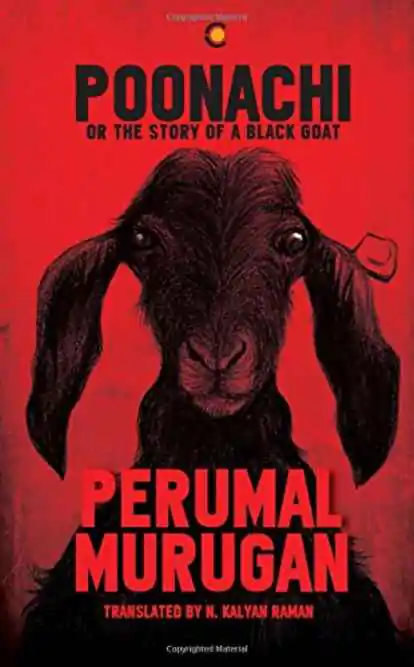
Murugan offers a modern fable through Poonachi: Or the Story of a Black Goat. Though the protagonist is an animal, the author presents an exhaustive characterization of Poonachi so readers can easily connect with her. Interested in this topic? Check out our round-up of best 21st-century authors!
Though the novel deceptively looks like a children’s book, it’s meant for adults. It addresses universal themes of being human and living. Some aggressive topics Murugan discusses via Poonachi are government injustice, social hierarchy, and racial discrimination. Read it on Amazon; click here.
“They talk about the highs of toddy and liquor, but those are not highs at all. Real intoxication comes from talking. The moment it crosses a limit, we forget everything.”
Perumal Murugan, Poonachi: Or the Story of a Black Goat
21. English, August by Upamanyu Chatterjee
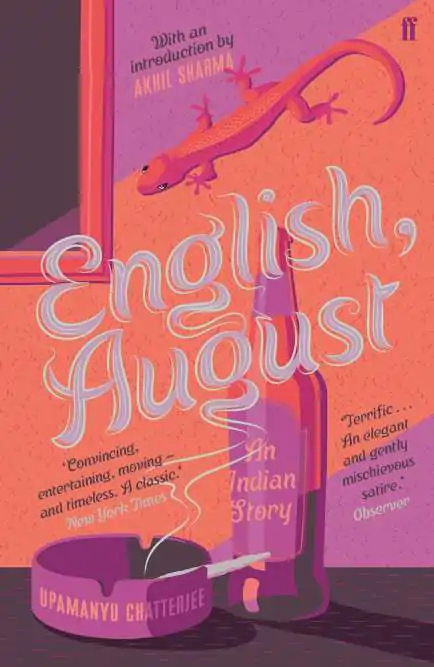
English, August revolves around a city boy’s self-discovery in the province. Despite seemingly having it all, he begins questioning his life purpose. As Upamanyu Chatterjee is fond of using morally gray characters, the protagonist’s dark side is shown to the readers. Agastya, or August, does bad things, making him listless and depressed. Read it on Amazon; click here.
“Only when you die will you cease to feel ridiculous.”
Upamanyu Chatterjee, English, August
22. The Far Field by Madhuri Vijay

The Far Field is akin to a confession and recollection. Throughout the novel, Shalini is searching for a part of her past to make sense of the crossroads she found herself in at 30. Vijay uses detailed descriptions and varied emotions from the book’s pages to the readers. Through this type of writing, she offers the readers an interesting and well-thought-out narrative. Read it on Amazon; click here.
“I don’t know when my allegiance shifted, when I went from being his to being hers.”
Madhuri Vijay, The Far Field
23. Serious Men by Manu Joseph
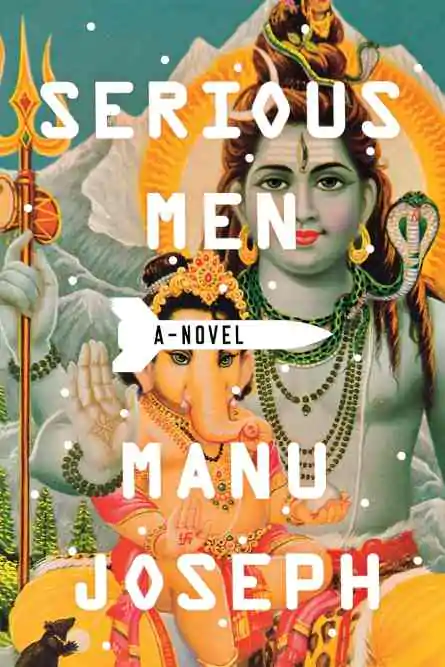
Get fascinated with unusual but amusing characters in Serious Men. Through carefully crafted narratives and an intricate plot, the journalist Manu Joseph manages to portray poverty in urban India in a satirical and relaxing novel.
Readers are taken to an adventure of how the poor Ayyan ends up in a beachside village. Despite being a funny and enjoyable book, Joseph points out power, caste, and political issues. Read it on Amazon; click here.
“But then the fate of shy people is that all of their fears usually come true.”
Manu Joseph, Serious Men
24. The Death of Vishnu by Manil Suri
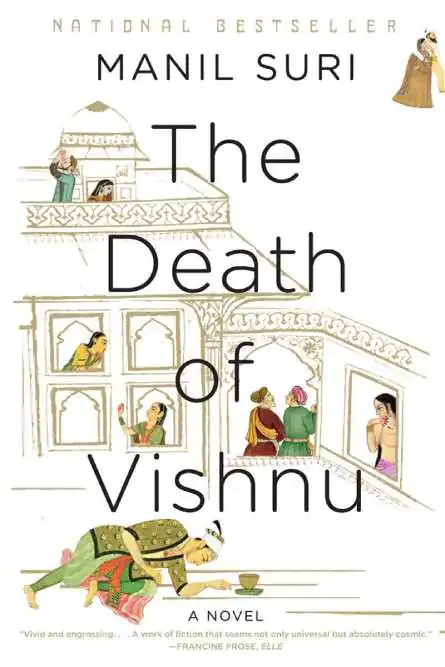
A man dying in an apartment complex — that’s the whole premise of The Death of Vishnu. Although the plot is straightforward, Manil Suri’s debut novel also untangles serious issues that divide modern India.
The novel starts with Vishnu’s dying on the apartment staircase, but Suri also presents the other resident’s backstory. He also loads the novel with Hindu myths and thus uses the building as a unique metaphor for India’s religion and social class. Read it on Amazon; click here.
“Endings need to be lived, they cannot be ordained.”
Manil Suri, The Death of Vishnu
25. A Fine Balance by Rohinton Mistry
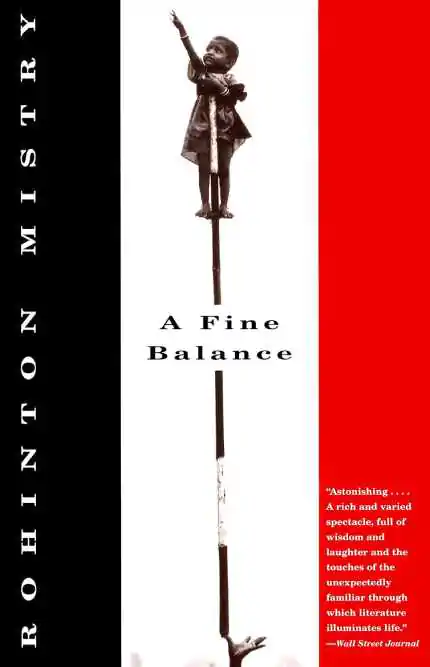
Greed, ignorance, and heroism are the main driving forces of the plot in A Fine Balance. Amidst the unrest in the 1970s, four people became roommates and close friends. Through their time together, readers are thrown in the middle of oppressed Indian citizens, where violence and poverty are normal.
Rohinton Mistry has the gift of drawing the harsh realities of the time. He also has a mesmerizing way of depicting authentic characters that make the readers root for them. Read it on Amazon; click here.
“Distance was a dangerous thing, she knew. Distance changed people.”
Rohinton Mistry, A Fine Balance
FAQs About Best Books Written by Indian Authors
Indian writers are well-known for their rich cultural and thematic mastery. They bring a unique blend of traditions, languages, and perspectives to their storytelling, offering fresh insights into various narratives. Many Indian authors excel in vividly depicting the complexities of Indian society, exploring themes like family, identity, and social change.
Indian writers frequently explore family dynamics, the clash of tradition and modernity, identity and self-discovery, and societal issues like caste and gender. Many Indian authors draw inspiration from Indian mythology, history, and cultural traditions, too. Themes of diaspora and the immigrant experience are also prevalent, reflecting the global Indian diaspora.